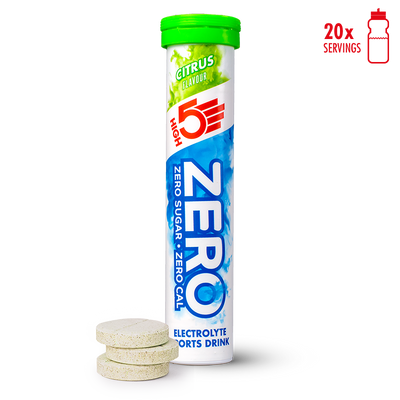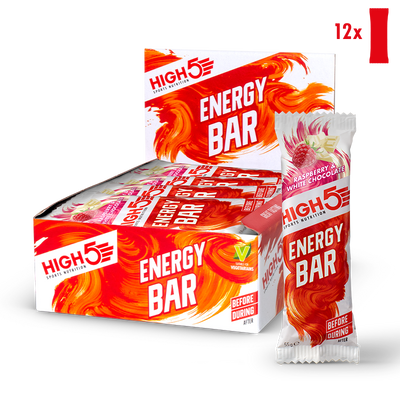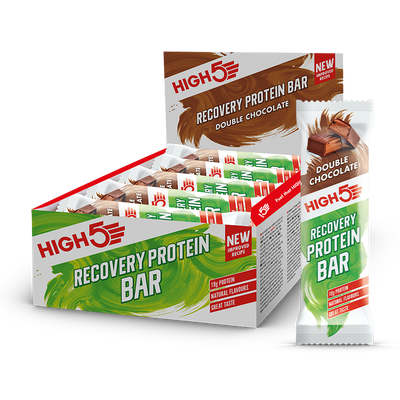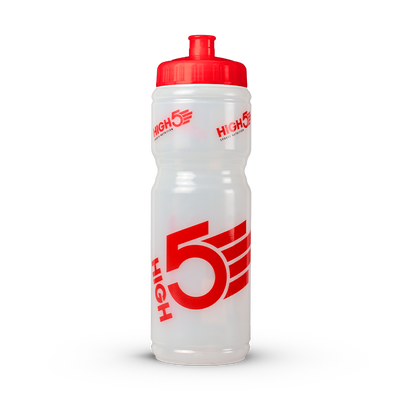Embracing the heat during your runs brings some challenges as well as benefits to your training. As temperatures soar, runners face unique hurdles that test both physical endurance and mental resilience.
Studies show that weather parameters can affect endurance running performance. Whether you're preparing for a race or striving for personal goals, understanding how your body responds to the heat is crucial.
Let's understand the effects of running in the summer heat with this guide.
Quick Fact: An average adult needs 1,600–2,000 mg of electrolytes per day. However, if you’re running in heat, this requirement may increase even more. A great way to beat the heat is by using HIGH5 hydration products to keep your electrolyte levels in check.
How Does Your Body React to Running in Hot Weather?
Running in different temperatures presents a spectrum of challenges and benefits for your body. Let's explore the nuanced reactions as you hit the pavement in various temperature ranges, understanding how to adapt your running routine accordingly.
Running in Temp between 10-15°C
In cooler temperatures, your body thrives. Blood plasma volume decreases while improving cardiovascular endurance. The brisk air aids in efficient cooling, making it an ideal range for comfortable and invigorating runs. Embrace the benefits of increased blood flow without the intensity of extreme temperatures.
Running in Temp up to 20°C
As the temperature goes up, so do the challenges for the body. Running in temperatures up to 20°C demands attention to hydration. Wear breathable fabrics and choose the right time, preferably early morning, to combat higher humidity levels.
Running in Temp between 20-26°C
Warm temperatures require adjustments in intensity. Running between 20-26°C may trigger an increase in perceived exertion. Choose lightweight clothing, stay hydrated with water or a sports drink, and be mindful of signs like muscle cramps. Learn how to stop cramps and run early in the morning for a more comfortable run.
Running in Temp between 26-31°C
The transition to high temperatures demands careful planning. Running in the heat between 26-31°C increases the risk of other heat-related illnesses. Hydration becomes paramount, and safety tips like avoiding extreme sunlight and adjusting your route for shaded paths are essential. Be aware of warning symptoms to prevent heat cramps and heat illness.
Running in Temp above 32°C
Running in hot weather at 32°C and above requires a strategic approach. We don’t recommend speed workouts or running temperatures higher than your internal body temperature unless you are used to it and have experience. Ensure that you consistently drink water or a sports drink, use moisture-wicking fabrics and adjust your running route to cooler areas. Ice water breaks and adjusting training schedules during peak heat hours are crucial safety measures.
Knowing how to train for a marathon while keeping an eye on the temperatures, heat index, and their impact on your body is the key to successful training sessions. Avoid running if the heat makes you weary and uncomfortable.

What are the Benefits of Running in Hot Weather?
Running in the heat isn't just a sweaty affair; it's an opportunity for your body to undergo transformative changes. As the temperatures rise, so do the potential advantages for your cardiovascular system, calorie-burning capacity, stress adaptation, and mental resilience.
In this exploration of running in the heat, we'll delve into the benefits that come with embracing the warmth, providing insights into how your body reacts and adapts, all while staying safe and smart.
Enhanced Cardiovascular Endurance
Running on hot summer days does more than just make you break a sweat. The increased temperatures prompt your body to adapt, leading to a boost in blood plasma volume. This enhanced cardiovascular endurance becomes evident as your heart works more efficiently, with more blood delivering oxygen to muscles with improved blood flow.
Increased Caloric Burn
As temperatures soar, so does the caloric burn during your runs. The combination of heat intensity and speed workouts creates a metabolic fire, helping you torch more calories. This becomes a powerful tool for those aiming to shed extra pounds or improve overall fitness.
Adaptation to Stress
The extreme heat challenges your body, fostering adaptation to stress. While caution is essential to avoid heat-related illnesses like heat cramps and heatstroke, exposing your body to warmer temperatures gradually teaches it to cope. This adaptation can act as a protective mechanism against other heat-related issues.
Mental Resilience
Early mornings provide the ideal setting for testing your mental resilience. The reduced humidity and cooler air create an environment where your body's ability to endure and overcome challenges is put to the test. This mental toughness becomes a valuable asset in long-distance running and race-day scenarios, helping you become a better runner.
Improved Sweat Efficiency
Investing in moisture-wicking fabrics and opting for light clothing are pivotal in enhancing sweat efficiency in humid conditions. Your body learns to regulate temperature and stay cool more effectively.
Natural Detoxification
Running in the heat promotes natural detoxification through increased sweating. Staying hydrated with water or a sports drink helps replenish electrolytes and essential minerals that may have been lost. In addition, adding ice water to your hydration routine during breaks helps cool your body, minimising the risk of heat-related issues.
Opportunities for Mental Clarity
Summer runs under the direct sunlight provide unique opportunities for mental clarity. The rising temperatures and high humidity levels, when approached mindfully, contribute to improved focus and a sense of well-being. Incorporating yoga into your morning heat training routine further enhances mental clarity, making your runs not just a physical activity but a holistic experience.
6 Dangers of Running in the Heat
Running in the heat can be a fulfilling experience, but it comes with potential risks that require your attention. Understanding these heat index risks is crucial to ensure your safety and well-being as you pursue your fitness goals.
1. Dehydration
Hot summer days pose an increased risk of dehydration during runs. As temperatures rise, your body loses more fluids through sweat. Maintaining optimal hydration levels is vital, especially when engaging in heat-related workouts. Knowing how to rehydrate fast also comes in handy. Incorporate sports drinks into your routine to replenish electrolytes and combat dehydration.
2. Overheating
Running in the heat can lead to overheating and an increase in internal body temperature, a condition that demands careful consideration. Extreme temperatures can challenge your body's internal temperature and its ability to cool down efficiently, resulting in an increased risk of heat-related illnesses. This is particularly true during blistering heat and sunlight exposure.
3. Muscle Cramps
Extreme heat and humidity levels elevate the likelihood of muscle cramps. Prioritise wearing cool and light clothing to stop cramps. These choices help regulate your body temperature, reducing the occurrence of muscle cramps during your summer runs.
4. Headache after Running
Experiencing a headache after running in the heat may be a sign of increased exertion and potential dehydration. Pay attention to alarming signs, such as persistent headaches, dizziness, or nausea, adjust your intensity, and prioritise hydration. Opt for early mornings or cooler evenings to minimise the impact of intense heat.
5. Nausea
The combination of high temperatures and strenuous activity can trigger feelings of nausea. Moreover, runners who have stomach pains when running may also feel nauseous. Listen to your body's signals and consider incorporating breaks into your run to cool down. Hydration is key to combating nausea, so make sure to drink water or sports drinks regularly.
6. Dizziness
Running in the heat can lead to dizziness due to a drop in blood pressure and dehydration. Be mindful of warning signs and, if necessary, reduce your pace or find shade to cool down. If you experience heat stress, remove as much clothing as possible. Including ice water breaks and adjusting your running route to shaded areas can contribute to preventing dizziness.

8 Effective Tips for Running in Hot Weather
Running in hot weather offers unique challenges but with the right strategies, running in heat benefits runners in the long run. Whether you're a seasoned runner or just starting, here are some essential tips to make your hot-weather runs bearable and enjoyable.
1. Build Gradually
Regularly expose your body to warm temperatures to gradually acclimate it to running in the heat. This gradual approach to heat training helps improve your ability to regulate core temperature and increases blood plasma volume for better cardiovascular endurance. Aim for consistent runs, but avoid pushing yourself too hard or running every day in extreme heat.
2. Carry a Wet Towel
Bringing a wet towel on your run can be a game-changer. Drape it around your neck or wipe your face to maintain your body temperature and cool down quickly. This simple trick helps combat heat stroke and overheating and enhances your comfort during intense heat.
3. Bring Lots of Water
Staying hydrated is non-negotiable on a hot day. Be mindful of the symptoms of dehydration that may appear due to a lack of fluids in your body. Bring a water bottle to ensure you have easy access to fluids throughout your run. It's also worth considering electrolytes, as they help get water to where it's needed more effectively, aiding hydration. Consider adding ice water to your hydration routine to cool your high body temperature and prevent the risk of heat stroke.
4. Slow Down
High temperatures demand a shift in pace. If you or your running partner is experiencing burnout, slow down and adjust your intensity to match the heat. This not only prevents overheating or heat exhaustion but also reduces the risk of muscle cramps and other heat-related issues. You can also splash some cold water on yourself to cool down your body.
5. Choose Your Route Carefully
Selecting the right route for running is crucial for a comfortable experience. Opt for shaded paths and avoid direct sunlight whenever possible. A well-thought-out route contributes to safer and more enjoyable runs in the summer months.
6. Pick the Right Time of Day
Timing is everything when it comes to running in hot conditions. Mornings or late evenings offer cooler temperatures and lower levels of humidity. This allows you to make the most of your runs without the intensity of midday heat and the risk of heat stroke.
7. Wear the Right Clothing
Your choice of clothing can significantly impact your body temperature in the hot-weather run. Opt for cooler fabrics and lightweight clothing to enhance sweat efficiency, aid in the cooling process, and prevent heat exhaustion. Avoid cotton, as it retains moisture and hampers your body's ability to regulate temperature.
8. Use Sunscreen
Protect your skin from direct sunlight by applying sunscreen before heading out. Running in hot weather exposes you to higher UV radiation, and sunscreen becomes an essential shield against sunburn and long-term skin damage.
To enhance your running performance and combat the common issue of heavy legs, especially under the scorching sun, explore our solutions for heavy legs when running. This guide will provide you with effective strategies to keep your legs feeling light and responsive, even on hot days.
Bonus Tip: When running in hot weather, make sure you consume an energy drink or isotonic hydration drink during the run to replenish fluids and electrolytes lost through sweating. These drinks provide both carbs for energy and electrolytes for hydration, making them the best products to take during your run in hot conditions.
Running in hot weather tips can help you enjoy your heat training without getting harmed by the hot weather.
Running in Hot Weather - Conclusion
Running in the heat can be challenging for endurance athletes, runners, and people who engage in intense physical activities. However, you can do it safely and effectively by observing safety precautions. By understanding the impact of extreme heat on your body temperature, you can minimise the risks associated with it. Moreover, with the right information, you can even make running in hot weather enjoyable.
Finally, when running in hot weather, you can make the most of HIGH5 hydration drinks and isotonic hydration drink to give your body adequate electrolytes.
lectrolytes.
Frequently Asked Questions
Running in hot weather vs cold – what are the differences?
The difference between running in hot vs cooler weather is that running in hot weather can lead to heat exhaustion. This makes it difficult to run long distances. In hot weather, the body risks dehydration, heat exhaustion, and overheating, demanding careful hydration and pacing. On the other hand, running in cold weather allows you to cover longer distances without the risk of heat stress. It increases your core body temperature, allowing you to stay warm even when the air temperature is low.
Does running in hot weather burn more calories?
Yes, running in hot weather can lead to increased calorie burn. The body works harder to cool itself on hot days through sweating, elevating the metabolic rate. However, it's essential to balance this with adequate hydration and be mindful of potential heat-related risks.
What to wear when running in hot weather?
When running in hot weather, opt for lightweight, breathable fabrics to enhance sweat evaporation and keep your body cool. Choose light-coloured clothing to reflect sunlight and reduce heat absorption. Consider breathable materials and, for added protection, wear a hat and sunglasses. Don't forget sunscreen to shield your skin from the sun's rays.








